Halo Display, Oslo, Norway ~ December 16, 2007
Halo Display, Oslo, Norway ~ December 16, 2007
On December 16, 2007, an extraordinary halo display was witnessed in Oslo, Norway. Contrary to popular belief that exceptional displays can only be seen in cold weather or Polar regions, this display occurred during high noon with the sun positioned at an altitude of over 50 degrees. The display spanned several hours and was observed from sites located 40 miles apart.
During this captivating event, a variety of atmospheric optical phenomena were observed, including:
-
Complete Parhelic Circle: The sky was adorned with a complete parhelic circle that cut through the sun. This phenomenon is characterized by a circular band of light that encircles the sky and is often associated with the presence of ice crystals in the atmosphere.
-
22 Degree Halo: A halo with a radius of approximately 22 degrees around the sun was visible. This type of halo is formed when sunlight interacts with hexagonal ice crystals in the atmosphere.
-
Circumscribed Halo: In addition to the 22 degree halo, a circumscribed halo was also observed. This halo appears as a bright circle around the sun and is caused by the interaction of light with randomly oriented ice crystals.
-
Sundogs: Sundogs, also known as parhelia, were spotted at a considerable distance from the sun. These bright spots are formed when sunlight is refracted by ice crystals and appear as bright patches on either side of the sun.
-
Parry Arcs: Unusual Parry arcs were seen during this display. Parry arcs are typically observed above an upper tangent arc when the sun is relatively low in the sky. They are caused by the interaction of sunlight with plate-shaped ice crystals.
-
Lowitz Arc: A rare and elusive Lowitz arc was also captured during this event. The Lowitz arc is a faint arc that appears below the sun and is caused by the refraction of light through horizontally oriented plate crystals.
The presence of these optical phenomena during the Oslo halo display is a testament to the diverse atmospheric conditions that can give rise to such captivating displays. It is interesting to note that the elevation of the sun during this event was similar to that observed by Professor Tobias Lowitz when he first recorded the Lowitz arc in June 1790 in St Petersburg. The high position of the sun during the Oslo display may have rendered the corresponding upper arc weaker, or it could be attributed to the limited rotation of plate crystals about the Lowitz axis.
The occurrence of these atmospheric optics phenomena can be explained through the interaction of sunlight with ice crystals in the atmosphere. The specific angles at which light is refracted and reflected by these crystals determine the formation and appearance of halos, arcs, and other optical effects.
The remarkable display witnessed in Oslo on December 16, 2007, provides a valuable opportunity for scientists and enthusiasts to study and understand the intricate workings of atmospheric optics. By analyzing the data and images captured during this event, researchers can further refine their models and simulations, such as HaloSim, to better predict and explain these awe-inspiring natural phenomena.
The persistence of Parry-oriented crystals in the sky throughout the display contributed to the formation of a low-sun Parry arc. Although the existence of Parry-oriented crystals may seem improbable, their efficiency in producing halos is noteworthy. Compared to other crystal orientations, a relatively small number of Parry-oriented crystals are needed to generate these optical phenomena.
In conclusion, the halo display observed in Oslo, Norway on December 16, 2007, showcased a stunning array of atmospheric optics phenomena. The occurrence of these phenomena during high noon challenges the notion that exceptional displays can only be witnessed in cold climates or Polar regions. This event serves as a reminder of the intricacies and wonders of our atmosphere, where sunlight and ice crystals interact to create mesmerizing displays of light. Through continued research and observation, we can deepen our understanding of these phenomena and unravel the mysteries of atmospheric optics.
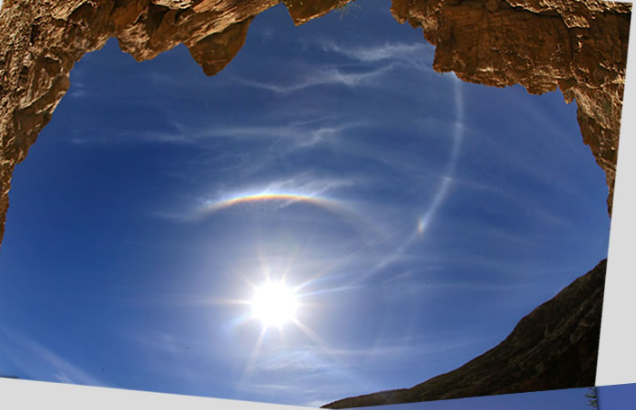
Left: The display from the Dead Sea by Koby Harati (photography) with the camera looking up almost to the zenith. ©Koby Harati, shown with permission.
The Israel display was seen from sites 40 miles apart and for several hours. The high noon sun of 50+ degrees altitude produced unusual halos and gave the lie to notions that outstanding displays can only be seen in cold weather or Polar regions.
At times a complete parhelic circle ringed the sky cutting through the sun, a 22 degree halo and a circumscribed halo.
Sundogs sat far from the sun.
Unusual Parry arcs were seen and even a rare Lowitz arc.
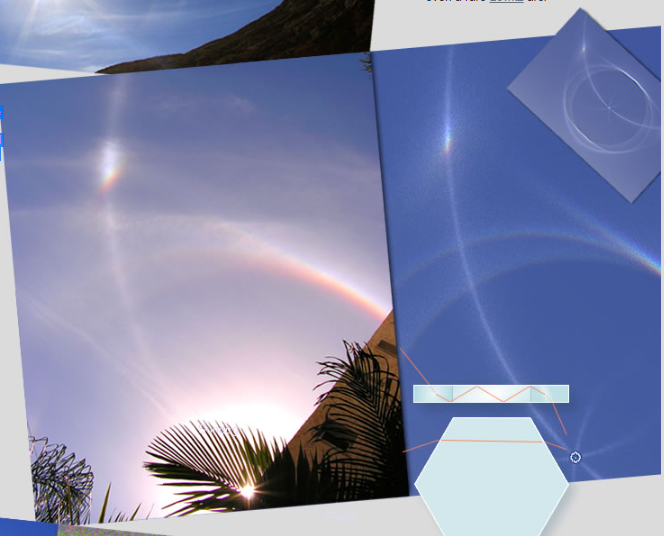
Right: Pennina Neumann captured the left hand sundog far along an intense parhelic circle and beyond the 22° and circumscribed halos. ©Pennina Nuemann, shown with permission.
For light from a high sun to form a sundog it must be reflected at least twice and an even number of times inside plate crystals.
Parry arcs are usually seen above an upper tangent arc when the sun is fairly low. Here the Parry arc is essentially tangent to the circumscribed and 22° halos and extends outwards to beyond the sundog. There is a vestige of a lower Parry arc too.
HaloSim produced the 30 million ray tracing simulation.
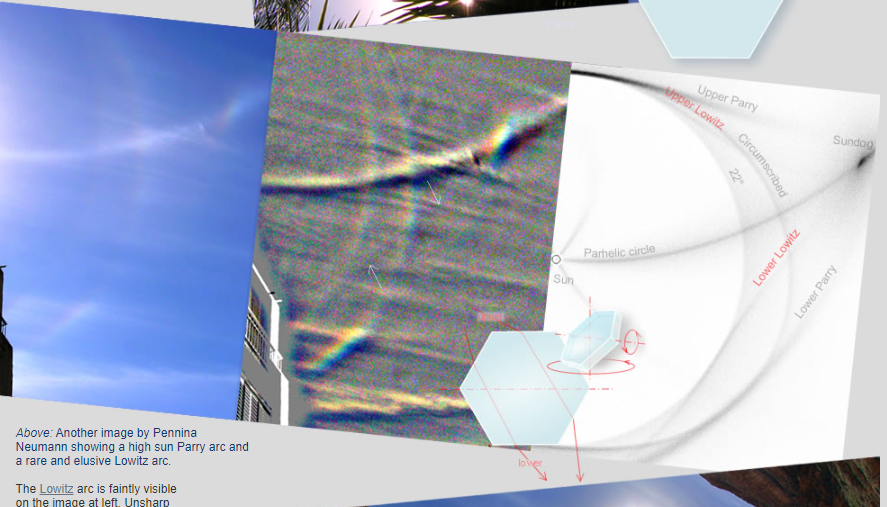
Above: Another image by Pennina Neumann showing a high sun Parry arc and a rare and elusive Lowitz arc.
The Lowitz arc is faintly visible on the image at left. Unsharp masking and embossing, centre, brings out the full lower arc. It appears on four separate images and corresponds well with the HaloSim prediction at right.
Interestingly, the sun's elevation was almost the same as that in St Petersburg when professor of chemistry Tobias Lowitz first recorded the controversial arc in June, 1790. He also saw only the lower arc. The high sun renders the corresponding upper arc weaker but its failure to show could also be due to plate crystals having only limited rotation about the Lowitz axis.
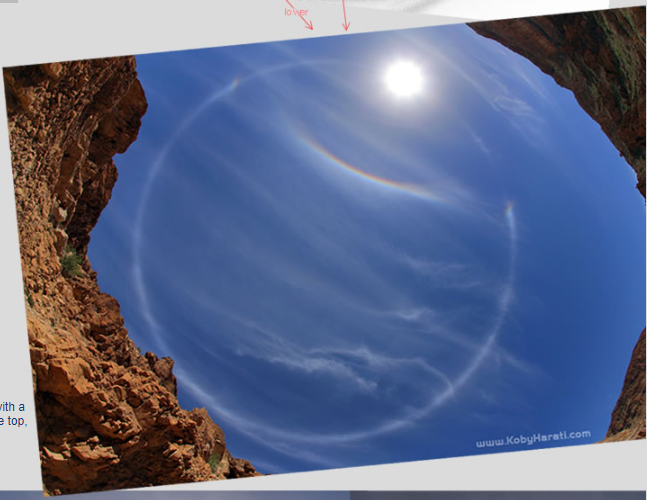
Right: Another view by Koby Harati with a complete parhelic circle and, near the top, upper and lower Parry arcs.
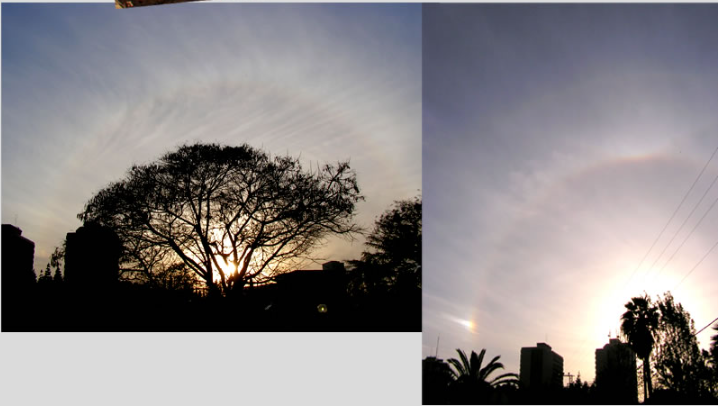
Right: The end of the day by Pennina Neumann.
Parry oriented crystals persisted in the sky to yield (far right) a more often seen low-sun Parry arc.
Parry orientated crystals seem most improbable but this is balanced by their great efficiency in producing halos. Not many of them are needed compared with other crystal orientations.
Note: this article has been automatically converted from the old site and may not appear as intended. You can find the original article here.
Reference Atmospheric Optics
If you use any of the definitions, information, or data presented on Atmospheric Optics, please copy the link or reference below to properly credit us as the reference source. Thank you!
-
<a href="https://atoptics.co.uk/blog/halo-display-oslo-norway-december-16-2007-2/">Halo Display, Oslo, Norway ~ December 16, 2007 </a>
-
"Halo Display, Oslo, Norway ~ December 16, 2007 ". Atmospheric Optics. Accessed on November 26, 2024. https://atoptics.co.uk/blog/halo-display-oslo-norway-december-16-2007-2/.
-
"Halo Display, Oslo, Norway ~ December 16, 2007 ". Atmospheric Optics, https://atoptics.co.uk/blog/halo-display-oslo-norway-december-16-2007-2/. Accessed 26 November, 2024
-
Halo Display, Oslo, Norway ~ December 16, 2007 . Atmospheric Optics. Retrieved from https://atoptics.co.uk/blog/halo-display-oslo-norway-december-16-2007-2/.